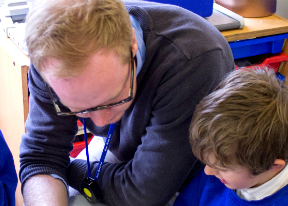A primary perspective on video for CPD
It is clear how important CPD is for improving teaching and learning; a substantial body of evidence supports this. But, what really makes the difference within primary schools?
Firstly, we need to understand the subtle differences that primary schools face when addressing their CPD needs.
- The school structure of one teacher per class limits the amount of time teachers can engage in CPD activities
- The smaller body of staff reduces the amount of resources to draw upon for further skills and knowledge
- The drivers for CPD are often based upon differentiation training, inclusion, engagement and progress, rather than having a subject emphasis seen in secondary schools
- Now, with limited budgets, schools are facing a cultural shift towards intra and inter school working to get more for less
This poses an interesting question - How does a primary school harness its own capacity to use the skills of its best teachers to overcome these challenges?
The aim of this post is to explore the use video for CPD. Why? Because I believe it can fully meet the many challenges of creating affordable, high quality, school-specific training and coaching that all primary schools deserve.
3 Models when considering video for CPD
Andrew Bushall, Chief Executive from Teachers TV, explores 3 different models when considering video for CPD.
- The first he describes as the ‘Training Video’- the long established “exemplar video in exemplar situations”. Often viewed as unrealistic and a top-down approach to providing learning opportunities for teachers.
- The second approach he discusses is ‘raw observational footage’ of the teaching process. He describes this model as “becoming increasingly prevalent as part of embedded CPD, primarily because it is based on a peer-to-peer model it asserts the priorities of reflective learning and it is self-evidently authentic.”
- The third model uses videos such as those provided by Teachers TV; combining a professional approach to production and the raw observational approach of classroom recording described above.
All 3 models work well at different stages of the learning and development cycle, and it’s excellent to have the benefits of video for CPD confirmed in this way.
Primary schools using IRIS Connect have seen sustained improvement and positive change in teacher confidence and classroom outputs. They have not only adopted the 2nd  approach, but combined that with tools and coaching strategies that enable teachers to do more than just view their own practice. They now actively discuss, share and comment upon a whole range of teaching practice. As well as digging deeper into learning behaviours, taking part in live coaching sessions and building libraries of practice using their own classrooms and students for all teachers to learn from.
approach, but combined that with tools and coaching strategies that enable teachers to do more than just view their own practice. They now actively discuss, share and comment upon a whole range of teaching practice. As well as digging deeper into learning behaviours, taking part in live coaching sessions and building libraries of practice using their own classrooms and students for all teachers to learn from.
Video by itself has an excellent part to play in CPD. However, when looking to overcome the CPD challenges presented in primary schools the following three schools showcase the importance of being able to live view, annotate, manage and share videos securely. It addresses the common problem around capacity. Most schools have what they need internally to improve, but they don’t have the effective means to share it.
Primary examples of using video for CPD:



Leave a comment:
Get blog notifications
Keep up to date with our latest professional learning blogs.